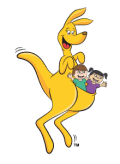Dr Jane Williams and Dr Tessa Grigg
‘Tis the season to be jolly’, or so the carol goes, but for many parents the holidays present additional stress. This article looks at why it is important to engage your child in physical activities over the holidays, which may ease the pressures, and it gives suggestions as to brain development activities that are essential at this time.
During the term many people have their pre-school children involved in programmes like GymbaROO-KindyROO, swimming and gymnastics. But during the holidays these programmes stop and children often spend increased time on screens while busy parents try to relax a little themselves.
We know that movement is beneficial for healthy brains (Misuraca, Miceli, & Teuscher, 2017). There is also a theory called Distributed Practice Theory (Donovan & Radosevich, 1999) which supports small amounts of regular practice being more effective than large, short practices. Teachers notice that after the long summer holidays many children have what is termed ‘summer learning loss’ (Sandberg Patton & Reschly, 2013) and research has shown that the brain needs regular stimulation and challenges to keep developing connections. Or to put it another way, people do not stop feeding their children vegetables because they are on holiday, we continue to give them healthy food, and movement is the good quality food your child’s brain requires even in the holidays – regardless of age.
Often parents resort to screens for their children to allow for down-time. We are not suggesting they don’t have any screen time, but we are encouraging you to think of alternatives to compensate for the reduced physical activities associated with the school term. The research on the development of your child’s vision and the regular use of small screens and mobile devices is now very clear. Professor Molina (2018), an Optometrist who lectures in Clinical Optometry, spoke at the INPP International conference in Spain in 2018, warning us that if we allow our very young children to use screens on a regular basis, they will join the 50% of the population who will need glasses….many by 8 years of age! Scary thought? Indeed it is! However, there are ways to avoid myopia (short-sightedness), and at GymbaROO we provide you with lots of activities that do just that!
At GymbaROO-KindyROO we ensure your child has lots of movement experiences and visual development time. Almost every activity has a visual purpose – whether it be visual-motor, visual-tactile, visual sequencing or visual integration tasks, our games and activities are designed to ensure your child’s brain and vision develop to be as healthy as possible. So, in the holidays keep these in mind as you plan your days.
Holiday activities that assist in the healthy development of the brain.
Here are some fabulous activities to enjoy with your child (instead of screen time!)
- Visit your local playground regularly. Children need time to play. Be mindful that in the holidays there may be bigger children at the playground and they do not always accommodate the needs of pre-schoolers.
- Make up your own obstacle courses with cardboard boxes, planks, old tires and other climbable, crawlable, jumpable objects to help develop motor and visual spatial skills.
- Play tactile games with playdoh, finger painting, pipe cleaners, cutting and gluing (3 years plus) to assist hand-eye coordination. Water play is fun in the summer as well.
- Water play/swimming. Children will play for ages in a paddling pool. Always watch children around water. Of course, the beach is a great place for many movement experiences.
- Give children access to small equipment, balls, home made instruments, bean bags (small for throwing and catching), fly swats and balloons.
- Include an age appropriate bike/trike/scooter (3 wheels for a 3-year-old and 2 wheels for a 4-year-old) / balance bike (2-year-old) as a present for Christmas.
- Look for nature walks. Children really enjoy exploring bush, walking through trees and beside streams. Take your time, and allow for bug watching and tree climbing.
As you plan your days in the holidays – ask the question “What movement activities (brain growing) am I including for my child today?” From the Toddler Kindy GymbaROO team, we hope you have a wonderful holiday time.
Donovan, J. J., & Radosevich, D. J. (1999). A meta-analytic review of the distribution of practice effect: Now you see it, now you don’t. Journal of Applied Psychology, 84(5), 795-805. doi:10.1037/0021-9010.84.5.795
Misuraca, R., Miceli, S., & Teuscher, U. (2017). Three effective ways to nurture our brain: Physical activity, healthy nutrition, and music: A review. European Psychologist, 22(2), 101–120.
Molina, V. G. (2018). Children’s vision challenges in the digital era. Paper presented at the International INPP Conference, Madrid, Spain.
Sandberg Patton, K. L., & Reschly, A. L. (2013). Using curriculum-based measurement to examine summer learning loss. Psychology in the Schools, 50(7), 738-753. doi:10.1002/pits.21704

